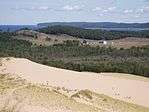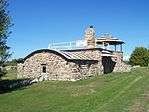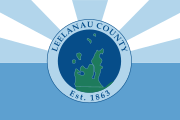Leelanau County, Michigan
| Leelanau County, Michigan | ||||
|---|---|---|---|---|
| County | ||||
| Leelanau County | ||||
From left to right: Leelanau countryside and Woolsey airport, near the tip of the Leelanau peninsula | ||||
| ||||
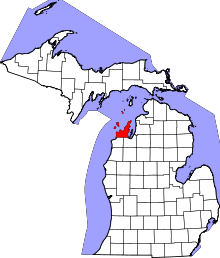 Location in the U.S. state of Michigan | ||||
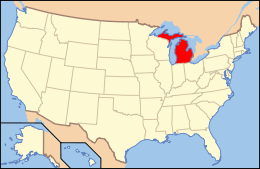 Michigan's location in the U.S. | ||||
| Founded |
1840 (created) 1863 (organized)[1] | |||
| Seat | Suttons Bay Township | |||
| Largest village | Suttons Bay | |||
| Area | ||||
| • Total | 2,532 sq mi (6,558 km2) | |||
| • Land | 347 sq mi (899 km2) | |||
| • Water | 2,185 sq mi (5,659 km2), 86% | |||
| Population | ||||
| • (2010) | 21,708 | |||
| • Density | 63/sq mi (24/km²) | |||
| Congressional district | 1st | |||
| Time zone | Eastern: UTC-5/-4 | |||
| Website |
www | |||
Leelanau County (/ˈliːlənɔː/ LEE-lə-naw) is a county located in the U.S. state of Michigan. As of the 2010 census, the population was 21,708.[2] The county seat was until recently the unincorporated community of Leland.[3] On August 3, 2004, county voters approved a proposal to move the county seat to Suttons Bay Township, closer to the county's geographic center. In 2008, the county offices completed their move to a new government center[4] built on 45 acres (180,000 m²) of county-owned land, one mile east of the unincorporated village of Lake Leelanau, where a new county law enforcement center was completed.
Leelanau County is included in the Traverse City Micropolitan Statistical Area of northern Michigan.
In 2011, the Sleeping Bear Dunes National Lakeshore, located in the county, won the title of "Most Beautiful Place in America" in a poll by morning news show Good Morning America.
Etymology
Traditionally, the county's name was said to be a Native American word meaning "delight of life",[1] but it is a neologism made up by Indian agent and ethnographer Henry Schoolcraft, who sometimes gave the name "Leelinau" to Native American women in his tales. He created many faux Indian place names in Michigan, from syllables from Ojibwe, Latin and Arabic. This source contends that the Ojibwas did not use the letter "L".[5] See, List of Michigan county name etymologies.
More recently, however, scholars have established that Leelinau was first used as a pen name by Henry's wife, Jane Johnston Schoolcraft, in writings for The Literary Voyager, a family magazine which they wrote together in the 1820s.[6] Jane Johnston was of Ojibwa and Scots-Irish descent, and wrote in Ojibwe and English. While her writing was not published formally in her lifetime (except as Schoolcraft appropriated it under his own name), Jane Johnston Schoolcraft has been recognized as "the first Native American literary writer, the first known Indian woman writer, the first known Indian poet, the first known poet to write poems in a Native American language, and the first known American Indian to write out traditional Indian stories."[7] In 2008 Jane Johnston Schoolcraft was inducted into the Michigan Women's Hall of Fame.[7]
History
The county was set off in 1840, and organized in 1863.[1]
Culture
Wineries
There are twenty six wineries on the peninsula.[8] The Leelanau Peninsula sits close to the 45th parallel, a longitude known for growing prestigious grapes. The two Grand Traverse Bays provide the ideal maritime climate and the rich soil does the rest. Northern Michigan specializes in growing white grapes and is known for its rieslings which grow well in the summer months and late fall which Traverse City is known for. Every October the wineries host a harvest fest. Some riesling grapes are spared being picked in the fall to be picked when they freeze, from which Ice Wine is made. Wineries in the Leelanau Peninsula AVA include Leelanau Cellars, Silver Leaf Vineyard and Winery, Gill's Pier Vineyard and Winery, Raftshol Vineyards, Circa Estate Winery, Forty-Five North Vineyard and Winery, Good Harbor Vineyards, Chateau Fontaine, Boskydel Vineyards, Black Star Farms, L. Mawby Vineyards, Ciccone Vineyard and Winery, Willow Vineyards, Chateau de Leelanau Vineyard and Winery, Shady Lane Cellars, Cherry Republic Winery, Longview Winery, and Bel Lago Winery.[9]
Geography
According to the U.S. Census Bureau, the county has a total area of 2,532 square miles (6,560 km2), of which 347 square miles (900 km2) is land and 2,185 square miles (5,660 km2) (86%) is water.[10] The county is coextensive with the Leelanau Peninsula.
The county has the second-highest proportion of water area of any county in the United States, behind only Keweenaw County, Michigan. Lake Leelanau is the county's largest body of inland water, formed from the Leland River dam near Leland. Glen Lake, located within the boundaries of Sleeping Bear Dunes National Lakeshore, is considered one of the most beautiful lakes in the world. A substantial portion of Sleeping Bear Dunes National Lakeshore lies within the county's borders, including North Manitou and South Manitou Islands. Leelenau has been party to substantial efforts to protect itself from growth, and to foster a nature conservancy.[11]
Transportation
Major highways
Adjacent counties
- Schoolcraft County - north
- Charlevoix County - northeast
- Antrim County - east
- Grand Traverse County - southeast
- Benzie County - south
- Door County, Wisconsin - west
- Delta County - northwest
Government
The county government operates the jail, maintains rural roads, operates the major local courts, keeps files of deeds and mortgages, maintains vital records, administers public health regulations, and participates with the state in the provision of welfare and other social services. The county board of commissioners controls the budget but has only limited authority to make laws or ordinances. In Michigan, most local government functions — police and fire, building and zoning, tax assessment, street maintenance, etc. — are the responsibility of individual cities and townships. Leelenau County recently completed construction of a new jail.
Elected officials
- Prosecuting Attorney: Joseph T. Hubbell
- Sheriff: Michael Borkovich
- County Clerk: Michelle L. Crocker
- County Treasurer: John A. Gallagher III
- Register of Deeds: Dorothy Miller
- Drain Commissioner: Steven R. Christensen
(information as of September 2005)
Demographics
| Historical population | |||
|---|---|---|---|
| Census | Pop. | %± | |
| 1860 | 2,158 | — | |
| 1870 | 4,576 | 112.0% | |
| 1880 | 6,253 | 36.6% | |
| 1890 | 7,944 | 27.0% | |
| 1900 | 10,556 | 32.9% | |
| 1910 | 10,608 | 0.5% | |
| 1920 | 9,061 | −14.6% | |
| 1930 | 8,206 | −9.4% | |
| 1940 | 8,436 | 2.8% | |
| 1950 | 8,647 | 2.5% | |
| 1960 | 9,321 | 7.8% | |
| 1970 | 10,872 | 16.6% | |
| 1980 | 14,007 | 28.8% | |
| 1990 | 16,527 | 18.0% | |
| 2000 | 21,119 | 27.8% | |
| 2010 | 21,708 | 2.8% | |
| Est. 2015 | 21,981 | [12] | 1.3% |
| U.S. Decennial Census[13] 2012 Estimate[14] | |||
As of the census[15] of 2000, there were 21,119 people, 8,436 households, and 6,217 families residing in the county. The population density was 61 people per square mile (23/km²). There were 13,297 housing units at an average density of 38 per square mile (15/km²). The racial makeup of the county was 93.52% White, 0.25% Black or African American, 3.66% Native American, 0.24% Asian, 0.02% Pacific Islander, 1.34% from other races, and 0.97% from two or more races. 3.29% of the population were Hispanic or Latino of any race. 23.3% were of German, 11.5% English, 9.9% Polish, 9.0% Irish, 6.0% French and 5.2% American ancestry according to Census 2000. 95.1% spoke English and 2.9% Spanish as their first language.
There were 8,436 households out of which 29.90% had children under the age of 18 living with them, 63.60% were married couples living together, 7.10% had a female householder with no husband present, and 26.30% were non-families. 22.30% of all households were made up of individuals and 8.80% had someone living alone who was 65 years of age or older. The average household size was 2.48 and the average family size was 2.89.
In the county the population was spread out with 24.40% under the age of 18, 5.70% from 18 to 24, 24.20% from 25 to 44, 28.30% from 45 to 64, and 17.40% who were 65 years of age or older. The median age was 43 years. For every 100 females there were 99.50 males. For every 100 females age 18 and over, there were 97.10 males.
The median income for a household in the county was $47,062, and the median income for a family was $53,228. Males had a median income of $35,719 versus $25,778 for females. The per capita income for the county was $24,686. About 3.30% of families and 5.40% of the population were below the poverty line, including 6.40% of those under age 18 and 4.50% of those age 65 or over.
Religion
Leelanau County is part of the Roman Catholic Diocese of Gaylord[16] and the Episcopal Diocese of Western Michigan.
Communities
Cities
- Traverse City (small portion)
Villages
Census-designated places
Unincorporated communities
- Burdickville
- Glen Haven
- Northport Point
- Peshawbestown
Townships
Notable people
- Famous author Jim Harrison was a long time resident of Leland Township; Former U.S. Secretary of Health and Human Services and former governor of Kansas Kathleen Sebelius vacations at a summer home built by her grandfather in Leland.[17][18]
- The northernmost village of Northport and surrounding Leelanau Township have achieved fame as an area where the rich and famous can live quietly and anonymously. According to the Leelanau Visitors Guide: "Chef Mario Batali lives north of town at Cathead point, and comedian and actor Tim Allen routinely spent summers in Northport until his divorce. Financier Mark Spitznagel summers in Northport Point, a posh community just outside the village."[19]
See also
- List of Michigan State Historic Sites in Leelanau County, Michigan
- National Register of Historic Places listings in Leelanau County, Michigan
References
- 1 2 3 "Bibliography on Leelanau County". Clarke Historical Library, Central Michigan University. Retrieved January 19, 2013.
- ↑ "State & County QuickFacts". United States Census Bureau. Retrieved August 28, 2013.
- ↑ "Find a County". National Association of Counties. Retrieved 2011-06-07.
- ↑ "'Nutcracker' performances set - www.leelanaunews.com - Leelanau Enterprise". leelanaunews.com.
- ↑ Michigan Arts and History on Origins of County Names.
- ↑ Jeremy Mumford, "Mixed-race identity in a nineteenth-century family: the Schoolcrafts of Sault Ste. Marie, 1824-27", Michigan Historical Review, 22 March 1999, pp.3-4, accessed 11 December 2008
- 1 2 Robert Dale Parker, Jane Johnston Schoolcraft, University of Illinois at Urbana-Champaign, accessed 11 December 2008
- ↑ Leelanau Wineries | Leelanau Peninsula Wine Trail
- ↑ Michigan Wines : Maps : Winery Tour Map : Northwest Region
- ↑ "2010 Census Gazetteer Files". United States Census Bureau. August 22, 2012. Retrieved September 26, 2014.
- ↑ "Home - The Leelanau Conservancy". The Leelanau Conservancy.
- ↑ "County Totals Dataset: Population, Population Change and Estimated Components of Population Change: April 1, 2010 to July 1, 2015". Retrieved July 2, 2016.
- ↑ "U.S. Decennial Census". Census.gov. Retrieved June 29, 2013.
- ↑ "Annual Estimates of the Resident Population: April 1, 2010 to July 1, 2012". Census.gov. Retrieved June 29, 2013.
- ↑ "American FactFinder". United States Census Bureau. Retrieved 2008-01-31.
- ↑ "The Diocese of Gaylord, Michigan : A Diocese of the Roman Catholic Church - Diocese of Gaylord". dioceseofgaylord.org.
- ↑ "Camp, Sebelius discuss Leland ties - www.leelanaunews.com - Leelanau Enterprise". leelanaunews.com.
- ↑ "Leland offers Sebelius respite from D.C.". Traverse City Record-Eagle.
- ↑ Leelanau Visitors Guide 2011.
Further reading
- "Bibliography on Leelanau County". Clarke Historical Library, Central Michigan University. Retrieved January 19, 2013.
- Bogue, Margaret. Around the Shores of Lake Michigan: A Guide to Historic Sites. Madison, WI: University of Wisconsin Press, 1985.
- Reed, Earl H. The Dune Country. Berrien Springs, MI: Hardscrabble Books, 1979. [Reprint of 1916 Edition].
- Ruchhoft, Robert H. Exploring North Manitou, South Manitou, High and Garden Islands of the Lake Michigan Archipelago. Cincinnati, OH: Pucelle Press, 1991.
- Wood, Mable C. Scooterville, U.S.A. Grand Rapids, MI: Eerdmans, 1962.
External links
- Official website
- Leelanau Peninsula Chamber of Commerce
- Glen Arbor Chamber of Commerce
- Leland Chamber of Commerce
- Northport-Omena Chamber of Commerce
- Suttons Bay Chamber of Commerce
- The Leelanau Enterprise (local newspaper)
- Leelanau.com (news, photos & links)
- The Leelanau Post
- Fountain Point Resort website
 |
Delta County | Schoolcraft County | Charlevoix County |  |
| Door County, Wisconsin | |
Antrim County | ||
| ||||
| | ||||
| Benzie County | Grand Traverse County |
Coordinates: 45°08′N 86°02′W / 45.13°N 86.03°W
